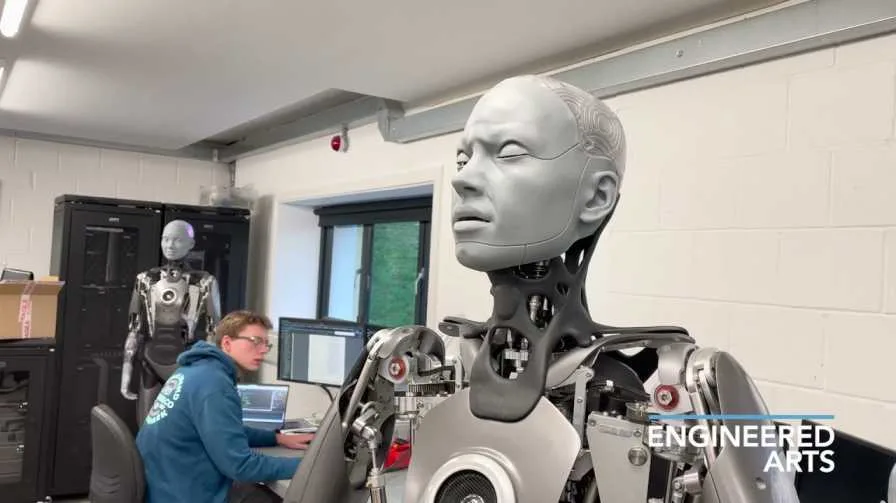World’s most advanced’ humanoid robot is unveiled in a UK lab with creepy realistic facial expressions and movements
The company behind human-like robots, Engineered Arts has unveiled a new creation that can amaze you even more. “Ameca” is a new humanoid robot that lacks lifelike hair and skin like the Mesmer models, can instead show more human, natural-looking expressions than other robots.
The Ameca robot is a fully articulated android. Its facial expressions and body language are realistic and it is reminiscent of Fallout synths. This new generation of robots is becoming more human-like, and we can’t wait to see it interact with people.
Cornish-based Engineered Arts calling itself “the UK’s foremost designer and manufacturer of humanoid entertainment robots”, enthusiastically presented the machine on YouTube. Many viewers expressed their amazement at how realistic and human the machine is.
The the articulated robot has a non-functional lower half, which means that it can’t walk. The robot’s upper half is fully functional, and Engineered Arts has performed research on walking robots, but the company hasn’t applied it to the robot.
Ameca’s realism and ability to look human are impressive, and it’s easy to see why Ameca is such a big hit with consumers and businesses alike. The robot is a humanoid entertainment robot modelled after a human. The company says it’s perfect for testing the abilities of artificial intelligence. However, the company’s marketing campaign has been overshadowed by the creepy video that was uploaded to YouTube.
Video Viewer Comments
- One user wrote: ‘I know we’re supposed to be scared of AI, but this is the first gynoid that hasn’t creeped me out. It’s pretty cool.’
- Another said: ‘It’s the eyes. People take for granted how important eyes are when it comes to something looking alive.
The rapid movement, the focus, the blinking, the attention they seem to pay to whatever is grabbing their attention.’
- A third added: ‘I seriously thought this was CGI at first. Great work! The hands look really well done too.’
It seems everyone was equally fascinated and uncertain as the video received a whopping 20 million views, with the tweet receiving 285,000 likes and over 100,000 shares on retweets and quote tweets as of (December 5)
It appears to have a fully articulated head, face, neck, shoulders, arms and hands, but Engineered Arts notes that none of its robots can walk – although the company is studying this capability. It’s not clear how Ameca’s facial expressions were animated, but some form of motion capture seems like a good bet. The company says Ameca is a “platform for AI development” but is allowing others to develop the necessary machine learning algorithms.
“Ameca was specifically designed as a platform for the development of future robot technologies and is the perfect humanoid robot platform for human-robot interaction,” the company said on its website.
Ameca follows the development of Sophia, who first emerged in 2016 and was a super-intelligent human-like head with a realistic face that was able to blink, look side to side and speak.
The humanoid robot, created by the Hong Kong firm Hanson robotics, can chat, smile mischievously, and even tell jokes. The robot made history in October 2017 when it became a legal citizen of Saudi Arabia.
The Operating System
The Ameca robot is powered by the Tritium operating system and is designed for demonstration purposes and is a prototype of the robot that Engineered Arts hopes to use to create a human-like robotic assistant
The Hardware
Engineered Arts previously stated that it uses “powerful, quiet, high torque” motors to control Mesmer’s body and head movements, with everything designed from the ground up to work perfectly together. It also uses sensors such as cameras, depth sensors, LiDAR, and microphones. To control motion, the company has developed browser-based software that works with many 3D applications used for visual effects or game animation.
The Movements
Ameca’s movements are based on what Engineered Arts calls degrees of movement. These degrees of movement can be found in the robot’s head, arms, torso, and hands, as well as in facial movements and expressions. All of these types of movements bring Ameca to life as he moves and uses his facial expressions to convey human emotions.
The Cost
There’s no information on pricing or availability for the Ameca or Mesmer, though the company’s simpler RoboThespian models reportedly sold for $ 79,000 and up in 2018.
Use Cases
The humanoid robot Ameca is designed to work with humans and provide recognisable natural human gestures. It is designed with upgradeable modular mechanics and can be controlled via a cloud managed API development kit. The company claims its robot has revolutionary advances in natural movement and gestures, intelligent interaction, and provides a future-proof software system. Engineered Arts also claims that its API offers customisation paths that weren’t previously available.
Designed specifically as a platform for development into future robotics technologies, Ameca is the perfect humanoid robot platform for human-robot interaction,’ the company said on its website.
‘We focus on bringing you innovative technologies, which are reliable, modular, upgradable and easy to develop upon.
Engineered Arts founder Will Jackson recently told the press that the capabilities of Ameca and the company’s previous robots are the result of over 15 years of research and development. He also said the company’s goal has remained the same – to create robots that are able to interact with people in human-like ways. ‘
One obstacle that the company has not overcome is that of walking. Engineering Arts says there are a lot of things that need to be overcome before Ameca can walk. Although they haven’t developed the ability to make Ameca mobile, they plan to improve its capabilities over a period of time and one day Ameca will be working on the track.
The company plans to showcase its robot at CES 2022 in Las Vegas, which will start early next year.







